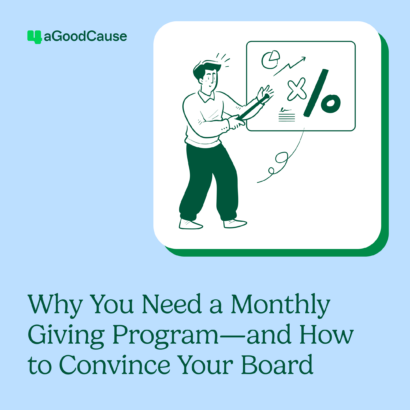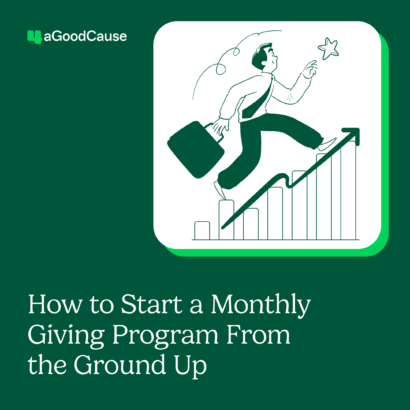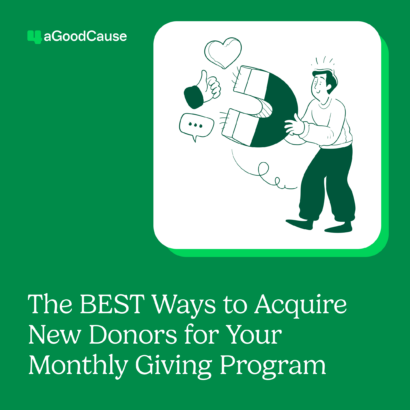When it comes to fundraising, many nonprofit organizations are hyper-focused on donor acquisition.
Of course bringing in new donors is important, and your organization should make a concerted effort to grow your donor base.
However, placing most of your organization’s resources on donor retention instead of donor acquisition is actually more lucrative in the long run.
It’s more cost-effective to get an existing donor to give again than it is to cultivate new donors. After all, existing donors have already displayed their affinity for your cause, so you don’t need to expend the resources on convincing them of the value of your cause and work.
Not to mention, recurring givers can give much more to organizations over time than one-time donors could give once. In fact, research has suggested that recurring donors give about 42% more over just one year than one-time donors.
Point is, to reach your full fundraising potential, your organization should be shifting your focus from donor acquisition to donor retention.
The issue is that the rise of online giving has made donor retention a new game. Many nonprofits aren’t sure how to develop effective stewardship plans for new online donors.
This article is here to help. We’ll discuss 5 best practices for retaining online donors, including:
- Immediately express your gratitude.
- Make recurring giving convenient.
- Personalize follow-up outreach.
- Offer additional engagement opportunities.
- Consider implementing mobile giving.
Now let’s start transforming those first-time online donors into donors for life!
1. Immediately express your gratitude.
How it’s done:
Stewardship should start the minute an online donor makes a contribution to your cause.
The first step to building long-lasting relationships is to express your gratitude and express it immediately.
The timing here is important. Your organization and the contribution is fresh on that donor’s mind, so you want to strike while the iron is hot.
If using online giving software, you can automate thank-you letters and donation receipts to send out over email right after donors have made a gift.
However, to get that relationship started on the right track, you should still follow up with a more personalized thank you note, acknowledging that donor’s specific contribution and welcoming them to your organization.
Why it works:
Properly acknowledging first time donors is important for two main reasons:
1. It makes the donor feel valued. Your donors aren’t giving to be recognized, but let’s be honest: we all like to feel like our good deeds are being valued accordingly. When you tell donors “thank you,” you’re illustrating to them that their gifts and philanthropy are important and appreciated.
2. It shows that you value that relationship. Saying “thank you” is integral to any relationship, not just with your donors, but with family, friends, and others in your personal network as well. Expressing your gratitude indicates to donors that you’re interested in continuing that working relationship with them, and building on it.
In simpler terms, acknowledging your donors shows them that you’re interested in them as individuals, not simply as donation transactions. And developing personal relationships will lead to donors feeling more invested in your cause.
The point is: Saying thank you is an integral first step to converting one-time givers into recurring donors, because it shows those donors just how much their support means to your organization.
Bonus: Check out 4aGoodCause’s article on the anatomy of a great thank-you email.
2. Make recurring giving convenient.
How it’s done:
Luckily, online giving software can really facilitate recurring donations.
You can place a field right on your online donation form where donors can set up automatic recurring donations.
Your software will automatically process donors’ payments once it’s time for them to make another gift, so your organization will have one less thing to worry about, too!
Why it works:
In a technology-driven age, people are only becoming more and more motivated by convenience.
This is especially true for online donors. Part of the reason they gave online was likely because it was convenient, and they didn’t have to take the time to write and mail in a check.
So essentially, the more convenient you can make recurring giving, the more likely your online donors are to follow through with it.
Placing the option to set up recurring on your donation page makes the process of setting up recurring giving a breeze. Donors won’t even have to leave the page and take an additional step to do so!
When getting started with recurring gifts is so straightforward, more of your donors will be inclined to do it.
And, in the most ideal cases, your online donors will see this option on your online donation form and set up recurring giving at the time of their first donation!
The point is: An involved process for setting up recurring giving can deter first-time online donors from making another gift. Make the process as convenient as possible by including automated recurring giving as an option on your online donation form.
3. Personalize your outreach.
How it’s done:
While many nonprofits will follow up with online donors after they’ve made their first contribution, some of those organizations still take a catch-all approach to their outreach.
However, to see the highest donor retention rates, it could not be more important to personalize your outreach based on your donors’ habits, interests, and preferences.
After a first-time donor has made a gift online, you should immediately record the data you collect in your nonprofit CRM (if your online giving software isn’t already integrated with your database). Doing so will allow you to start building a profile that will give you the most comprehensive insights into your donors.
Then, start developing a personalized outreach strategy based on the information you receive from that donor. At this point, you probably won’t have much to go off of besides:
- That donor’s name.
- Their contact information.
- Their gift size.
- The fact that they likely prefer giving online.
While this information is certainly basic, it can still provide you with plenty of key insights you can use to start customizing your outreach.
The first step, of course, will be sending that personalized thank you mentioned earlier. Make sure to use the donor’s name in the salutation, recognize that this is their first contribution, and specifically reference their gift amount.
You also know that it’s likely the donor prefers engaging with you through digital channels, so you can send your follow up outreach through email (as opposed to direct mail or other channels).
Additionally, you can target that donor with other digitally-based engagement opportunities (such as signing up for your email newsletter or following your social media pages).
Why it works:
Personalizing your outreach is another way to show donors that your organization is invested in them as individuals, not just as potential donations. It suggests to donors that you’re attentive to their particular habits and preferences.
Additionally, it makes your outreach more relevant.
When you’re sending donors content through their preferred channels with the engagement opportunities that are most likely to appeal to them, they’re far more likely to keep contributing to your organization.
The point is: Customized outreach leads to a more personal and pertinent experience for your donors. When your donors feel valued as individuals and can see how your work speaks to their interests and preferences, there’s no reason why they shouldn’t keep giving to your organization.
4. Offer additional engagement opportunities.
How it’s done:
To build a relationship with your donors, you have to continue interacting with them outside of the context of their first gift.
The only way to do so is by offering those donors plenty of additional opportunities to interact with your organization.
When crafting outreach strategies, you should be thinking of different ways you can target new online donors with relevant and appealing engagement opportunities.
The only hard rule here is that you shouldn’t be making another ask. After all, these donors just gave, so requesting more money can be potentially alienating.
Instead, ease your donors into more regular involvement with your organization by offering simple, small-scale engagement opportunities. Since these donors are giving online, some excellent options would be requesting that they sign up for your email or text list or following you on social media, as mentioned above.
If your donors have a warm response to these opportunities, you can start sending them information about other opportunities that require more involvement.
Some of the best opportunities you can provide are fundraising or appreciation events.
The opportunity to interact with your organization in person can make new online donors feel more connected to your cause.
One of the downsides to giving online is that it’s a more detached and impersonal process, so having a face to put to your organization can really help online donors feel more personally invested in your cause and work.
Why it works:
Your first-time donors already took the first step and initiated a relationship with your organization. Now the ball’s in your court!
By providing additional engagement opportunities, you’re taking an active approach to building relationships with your new donors.
Furthermore, you’re showing those donors that their contributions are valuable to you and that you want those relationships to endure.
Plus, providing additional engagement opportunities only gives you more chances to get to know your supporters, so you can customize your outreach even more down the line. And we already talked about how personalized outreach leads to heightened retention!
But even more important is what providing other opportunities to get involved can do for your donors:
1. It helps them feel more connected to your organization. Each time a donor interacts with you (or even each time a donor is offered an opportunity), they become a little more invested in your organization. Not only are they getting to know your cause and work better, but they’re also putting an increasing amount of time and resources into supporting you.
2. It allows them to choose their own involvement. Providing other engagement opportunities will make it clear to your donors that there is more than one way they can support your cause. When they can choose how they support you based on what’s interesting and convenient to them, they’ll be more likely to do so.
The bottom line is that there are myriad reasons why providing additional engagement opportunities leads to more recurring gifts.
Don’t forget to outline other ways to get involved in your outreach!
The point is: By providing first-time donors with additional engagement opportunities, you’re actively furthering those relationships, getting to know those donors better, and helping them feel more invested in your cause. All of these factors make retention more likely.
Bonus: Read 4aGoodCause’s tips on how to boost donor retention with fundraising events.
5. Consider implementing mobile giving.
How it’s done:
There are many forms of mobile giving out there, perhaps the most popular of which is text-to-give.
If your organization isn’t already accepting donations over mobile, you’ll have to:
- Gauge your base to see if mobile giving would be right for you/
- Determine which type of mobile giving would be most fitting.
- Ensure you have someone on your staff who can oversee this channel.
- Look into different providers to see which service can best accommodate your needs.
Adopting any new kind of technology will take some careful research and consideration on your part, so make sure you have all of your bases covered before you make an investment.
Why it works:
While this point might seem less intuitive than some of the others we’ve covered here, hang with me for a minute.
Donors who have given online have indicated that they’re responsive to digital channels. Furthermore, they’ve displayed that they’re likely motivated by convenience.
There’s perhaps no donation channel more convenient than mobile giving.
That’s because:
- Donors can give from anywhere, the minute the fancy strikes.
- Donors will be using a platform they’re already very familiar with.
- Donating usually takes only 2 or 3 simple steps.
Your new online donors have already indicated that the affinity for your cause is there. The hardest part to getting them to give again (besides keeping them engaged) is making the process of further involvement as easy as possible.
Mobile giving does just that!
If you feel this option could be right for your organization, you should give it a try. You’ll see more donations for it!
The point is: Mobile giving is a technologically advanced and convenient giving channel that speaks to online donors’ preferences. When you meet donors where they want to be met, you increase the likelihood that they’ll become recurring contributors.
Bonus: Check out 4aGoodCause’s video on how to create an amazing mobile giving campaign.
As you can see, retaining online donors isn’t that different from retaining donors who give through more traditional channels.
All it takes is developing a thoughtful and customized approach that speaks to your donors as individuals and takes into account their unique relationship with your organization.



